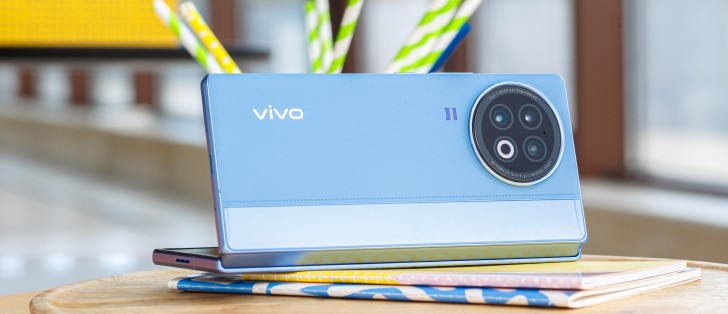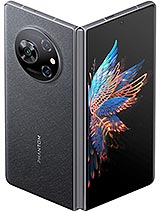vivo X Fold2 review

OriginOS 3 on top of Android 13
The X Fold2, being a China-only device, runs on that local branch of custom software - Origin OS, as opposed to the Fun-touch OS that global vivos get. The version on our review unit is Origin OS 3, on top of an Android 13 core.

It's got very different visuals in many ways, and there's the occasional disparity in functionality, but for the most part, the feature set is similar between the two branches. But let's first go over the cover display functionality.

It supports Always-on display with a bunch of preset styles, but you can customize one on your own. There's even a feature that turns the phone into a desk calendar so you can place the phone slightly unfolded on your desk and see the time and date at all times. The rest of the display settings are global, meaning that everything you apply on the main internal screen will be applied to the external one as well.
Once on the large screen, you start noticing the differences between Origin and Funtouch. Among the more notable ones is the design of the quick toggles and notification shade. Similarly to MIUI, there are two separate panes that you can switch between with side swipes, as opposed to the two-in-one default Android behavior, which is also implemented in Fun-touch. The quick settings toggles drop all the way down to the bottom half of the screen, making them very easy to access with one hand.


Home screen, notification shade, quick toggles
And since Android has come a long way since the first foldable, the system offers several built-in features. For instance, most apps we tried, including some third-party ones, will split the app menus into two - the left side will keep open the main menu while the right half changes depending on your selection. See the general Settings menu. There's also a dedicated dock on the home screen that displays your frequently used apps and looks like macOS' dock.
In addition, the software allows you to customize the behavior of apps on the foldable screen as well as dock the taskbar and show it on top of full-screen apps as well.
All these small adjustments make up for a great multi-tasking experience and make the most out of the large foldable screen.
Back to OriginOS itself. The lockscreen doesn't hold surprises, but beyond that, Origin does take a different approach to Fun-touch. You can have large folders with immediately accessible icons in them or a more conventional openable folder, which still has a twist - you can put kits in there, Origin's name for widgets.
The recent apps and app drawer are shared between Origin and Fun-touch. For the recent apps menu you can choose between the standard carousel formation and a tile layout - sort of like MIUI, only scrollable horizontally. The setting is available right then and there - you don't need to look for it in the menus.
The app drawer is missing the expandable recommended apps category on the top (most commonly used ones), but it does feature the vertical scroller on the right that highlights the apps beginning with the selected letter.
Many customization options are at your disposal, letting you personalize the UI to your liking. A theme store is also available. The always-on display settings are in a different sub-menu, but the phone still gives you plenty of options to tinker with - a wide selection of animations, clock styles, colors, and backgrounds.
Dynamic Effects sub-menu, vivo has grouped a bunch of further customization options for the home screen, lock screen and animation effects. There are even various charging and facial recognition animations. The Smart Motion menu holds a handful of familiar screen-on and screen-off gestures.
As far as the fingerprint readers are concerned, they are both reliable, super fast and responsive. And you don't need to set up both separately; you need to train just one, and your fingerprint data is shared.
Holding the volume down key can be used to launch an app or do a certain task, although the list is limited to the camera app, turning on/off the flashlight, starting audio recording, open Facebook, or open any custom app. The so-called Quick action feature doesn't work when playing music for obvious reasons. There's no double-press option for Quick action, though.
A dedicated Ultra Game Mode is available, offering a ton of features to mitigate disturbance during gameplay or preventing certain apps from displaying notifications.
Performance
The vivo X Fold2 is powered by Qualcomm's latest flagship chipset - Snapdragon 8 Gen 2 - that's based on TSMC's 4nm manufacturing process. This is in line with the most 2023 flagships, and it's a step up from its more affordable X Flip sibling.
The new chipset has an octa-core processor with one prime core, four performance ones (2+2), and three efficient cores a.k.a. 1+2+2+3 configuration. This means the CPU contains 1x3.2GHz Cortex-X3 + 2x2.8 GHz Cortex-A715 & 2x2.8GHz Cortex-A710 & 3x2.0GHz Cortex-A510 CPU cores.

The Snapdragon 8 Gen 2 chipset comes with Adreno 740 GPU capable of Ray Tracing. Whether and how that gets used in actual mobile games remains to be seen in the future.
The new Gen 2 chipset offers 35% higher performance and 40% improved efficiency in the CPU department over its Gen 1 counterpart and 25% and 45% performance and efficiency bumps on the GPU side of things. It also has support for new, faster memory technologies (LPDDR5X and UFS 4.0).
There are only two memory variants, both of which come with 12GB of RAM, but you can choose between 256 or 512GB of internal storage. We have the 12GB/512GB option in our hands.
Perhaps it's not all that surprising to see the X Fold2 topping the performance charts since most competitors haven't updated their foldable flagships to the Snapdragon 8 Gen 2.
Reader comments
- Cooldude
- 20 Mar 2024
- Iby
Yes, but it scratches easy
- Anonymous
- 15 Mar 2024
- IbG
HONOR MAGIC V2 is a better option with all its aspects
- Just this person
- 07 Jul 2023
- 7ye
I have and love this phone. :-o It's truth.
































